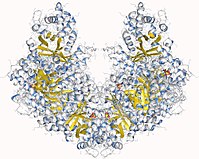
Photo from wikipedia
Emerging fungal phytodiseases are a food security threat and novel fungicides are in an urgent need. Herein, a series of isobutyrophenone derivatives were designed and synthesized. The derivatives exhibited excellent… Click to show full abstract
Emerging fungal phytodiseases are a food security threat and novel fungicides are in an urgent need. Herein, a series of isobutyrophenone derivatives were designed and synthesized. The derivatives exhibited excellent fungicidal activities against seven fungi. The structure-activity relationship (SAR) study indicated that the introduction of a bromo group at the position 3 or 5 of the phenyl ring, as well as esterification of the 4-hydroxy with a chloroacetyl group, could substantially increase the antifungal activity and spectrum of the compounds. Among all 23 compounds, 2-bromo-3-hydroxy-4-isobutyryl-6-methylphenyl 2-chloroacetate (12b) showed the highest fungicidal activity against all seven tested fungal pathogens with EC50 values ranging from 1.22 to 39.94 μg/mL and exhibited the most potent inhibition against class II fructose-1,6-bisphosphate aldolase with an IC50 of 3.63 μM. The lead compounds were proven to be safe to NIH3T3/293 T cells and silkworm larvae, and relatively stable under different harsh conditions. Detached fruit tests showed the practical potential of lead compounds for fruit (or plant) protection. Taken together, our results indicated that the isobutyrophenone derivatives could be further optimized and developed as advanced leads for new fungicides.
Journal Title: Pesticide biochemistry and physiology
Year Published: 2019
Link to full text (if available)
Share on Social Media: Sign Up to like & get
recommendations!